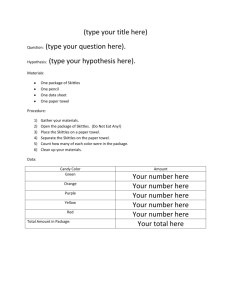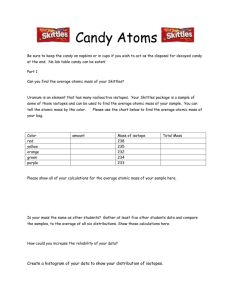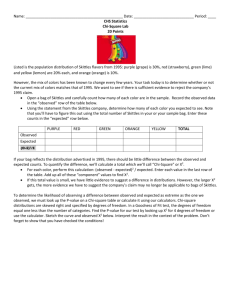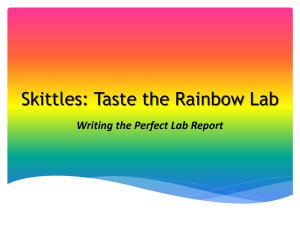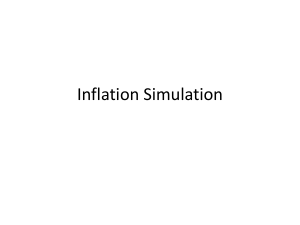Subject Areas: Activity Title: Grade Level: Time Required:
advertisement
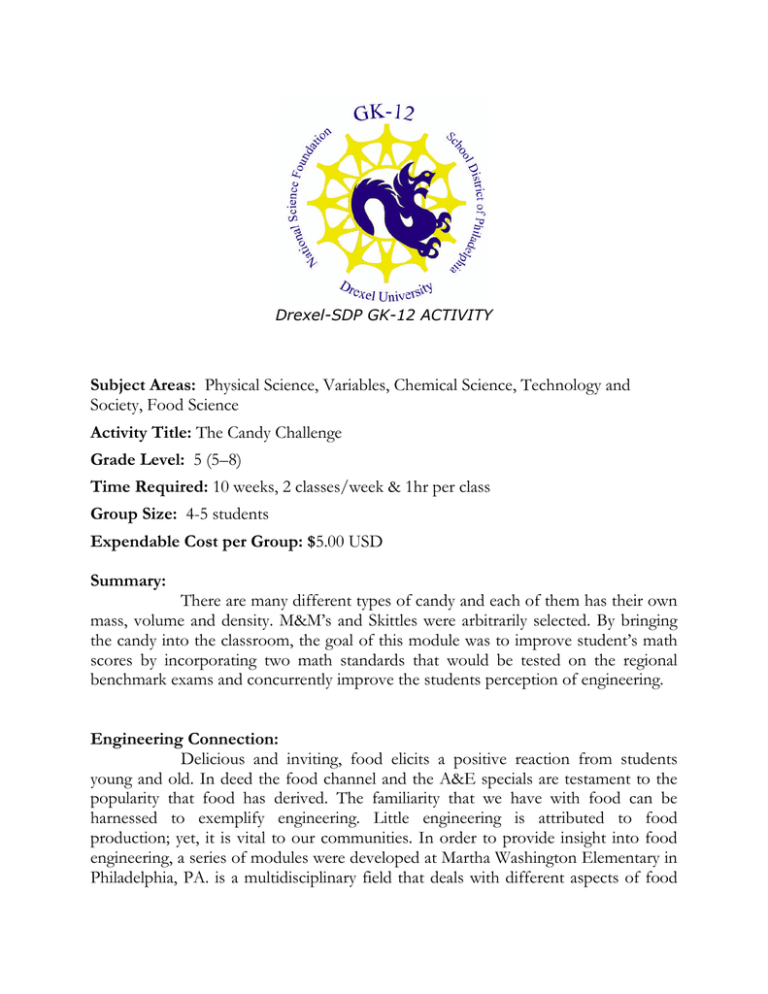
Drexel-SDP GK-12 ACTIVITY Subject Areas: Physical Science, Variables, Chemical Science, Technology and Society, Food Science Activity Title: The Candy Challenge Grade Level: 5 (5–8) Time Required: 10 weeks, 2 classes/week & 1hr per class Group Size: 4-5 students Expendable Cost per Group: $5.00 USD Summary: There are many different types of candy and each of them has their own mass, volume and density. M&M’s and Skittles were arbitrarily selected. By bringing the candy into the classroom, the goal of this module was to improve student’s math scores by incorporating two math standards that would be tested on the regional benchmark exams and concurrently improve the students perception of engineering. Engineering Connection: Delicious and inviting, food elicits a positive reaction from students young and old. In deed the food channel and the A&E specials are testament to the popularity that food has derived. The familiarity that we have with food can be harnessed to exemplify engineering. Little engineering is attributed to food production; yet, it is vital to our communities. In order to provide insight into food engineering, a series of modules were developed at Martha Washington Elementary in Philadelphia, PA. is a multidisciplinary field that deals with different aspects of food production and processing. Using the student’s familiarity with candy provides an excellent way to introduce middle school students to the sweeter aspects of engineering through a module that covered several scientific concepts. Students will learn about volume using a graduated cylinder, statistics and graphing to answer the question, “which has more mass an M&Ms or Skittle?” This activity can be used to augment curricular lessons, especially those involved in formulating experiments, analyzing data and answering questions. The students by the end should become familiar with the basics of mass. Students will learn about density using data that they have previously collected. Density is covered in their science books and this activity supplemented a series of experiments using paper cups to determine density of coins. This activity can be used to augment curricular lessons, especially those involved in analyzing data and answering questions.. Keywords: Food, Engineering, Candy Educational Standards: Science: 3.1.7 a, d, e 3.2.7 a, b, c Math: 2.2.5 2.6.5 Learning Objectives: After this lesson, students should be able to: Learn to find and calculate the volume of materials. Learn to collect data and present it in graphs. Learn to answer open ended questions with the available data. Understand what mass is. Learn to find and calculate the mass of materials. Learn to collect data, graph data, and interpret data. Learn to answer open ended questions with the available data. Understand what density is. Learn how to calculate the density of materials. Learn to answer open ended questions with the available data. Materials List: 2 Each student needs: Lab notebook Pen or pencil Calculator Each group needs: 1 bag of M&Ms 1 bag of Skittles 1 graduated cylinders Introduction / Motivation: Students should be familiar with the different types of graphs (line, bar and pie) in addition to converting from fractions to decimals. In addition, students should be familiar with averaging and collecting data. The goal is to get them familiar with volume, how to calculate volume and making predictions using mathematical tools. To accomplish the student’s goal, they were prompted to write in their science journals. Students will learn about volume using a graduated cylinder, statistics and graphing to answer the question, “which has more mass an M&Ms or Skittle?” This activity can be used to augment curricular lessons, especially those involved in formulating experiments, analyzing data and answering questions. The students by the end should become familiar with the basics of mass. Procedure: Prelab Have the students must write in their lab journals, which do you think is bigger a Skittle or an M&M? And why? Collect the class data and have the students make a pie chart. Have students write. How does your guess compare to the class? Introduce units of volume. mL=cc=cm^3 and tell them units go with numbers Lab Give each student or group of students a cup of M&Ms, a cup of Skittles and a graduated cylinder. The students measure the volume of the M&Ms and the volume of Skittles by pouring the Skittles and then the M&Ms into the graduated cylinders and measuring the volume. The prompts for the students to write in their science journals are: Collect individual or group data o What is the volume of M&Ms in your cup? 3 o How many M&M’s are in your graduated cylinder? o What is the volume of Skittles in your cup? o How many skittles are in your graduated cylinder? o Have the students calculate the volume of one piece of candy. o Use this equation to find the volume of one piece of candy. Volume one piece of candy = (volume of the cup of candy)/(the number of candy pieces) o So which is bigger a skittle or an M&M? Postlab Collect the group’s data on the volume of M&Ms and Skittles and have the students compute the average size and make charts of the distribution of sizes. The students then were asked to analyze their results. The question posed to them was, “the volume we measured is not a true volume of the M&M? Why?” The students should notice that there are spaces between the M&M’s and Skittles. To demonstrate the error, fill the graduated cylinder with water measure the volume. Then add ten pieces of candy and measure the volume. Subtract the final volume minus the initial volume divided by ten to get the true volume. Explain that the water fills in that space so only the M&M’s volume is measured. o Graph the distribution of M&M volume. o Graph the distribution of Skittles volume. o How did our initial guess hold up to our experiments? o The volume we measured is not a true volume of the M&M and Skittles, is there an error? Why? Prelab Have the students write in their lab journals, which do you think has more mass a Skittle or an M&M? Why? Collect the class data and have the students make a pie chart. Have students write. How does your guess compare to the class? Introduce units of mass. Grams and ounces and tell them units go with the numbers that you measure with a balance or scale. Lab Give each student or group of students a cup of M&Ms and a cup of Skittles. Walk around to each group and introduce the balance what it can do. The students measure the mass of the M&Ms and the mass of Skittles by pouring the Skittles and then the M&Ms into the balance and measuring the mass. The prompts for the students to write in their science journals are: Collect individual or group data o What is the mass of M&Ms in your cup? 4 o How many M&M’s are in your cup? o What is the mass of Skittles in your cup? o How many Skittles are in cup? Have the students calculate the mass of one piece of candy. o Use this equation to find the mass of one piece of candy. mass one piece of candy = (mass of the cup of candy)/(the number of candy pieces) So which has more mass a Skittle or an M&M? Postlab Collect the group’s data on the mass of M&Ms and Skittles and have the students compute the average size and make charts of the distribution of sizes. The students then were asked to analyze their results. The question posed to them was, “the mass we measured is not a true mass of the M&M? Why?” The students should notice that the scale is not that precise. Graph the distribution of M&M mass for the class data. Graph the distribution of Skittles mass for the class data. How did our initial guess hold up to our experiments? The mass we measured is not a true mass of the M&M and Skittles. o What is the true mass of the candy pieces? mass one piece of candy = (mass of the bag of candy)/(the number of candy pieces in the bag) o How big is the error? Why? Students should be familiar with the different types of graphs (line, bar and pie) and converting from fractions to decimals. Also, students should be familiar with averaging, collecting data, mass and volume. The goal is to get students familiar with density, how it is calculated and making predictions using mathematical tools. To accomplish this, the students have to rely on their lab notebooks and previous experiments and the following prompts to write in their science journals. What is the volume of the class averaged M&M? What is the mass of the class averaged M&M? What is the volume of the class averaged Skittles? What is the mass of the class averaged Skittles? Calculate the density of Skittles and M&Ms. Density of one piece of candy = (Mass of the candy)/(Volume of candy) So which is more dense a Skittle or an M&M? The students read a section of their science books on Archimedes and density. As part of the reading activity, density and buoyancy where explained. The question posed was, “would the M&Ms sink or float? Support your answer?” 5 Methods and Procedure: This includes Pre-Investigative Work (if any) Investigative Work What evidence do students collect? How do students present evidence? What conclusions are drawn from the evidence? Include example of data sheets Assessment: Laboratory notebook Activity Extensions: None Other: FOSS Solar Energy Unit http://lhsfoss.org/scope/5-6.html Author: Michael Birnkrant Owner: Drexel University GK-12 program, Engineering as a Contextual Vehicle for Science and Mathematics Education, supported in part by National Science Foundation Award No. DGE-0538476 Copyright: Copyright 2008 Drexel University GK12 Program. Reproduction permission is granted for non-profit educational use 6
